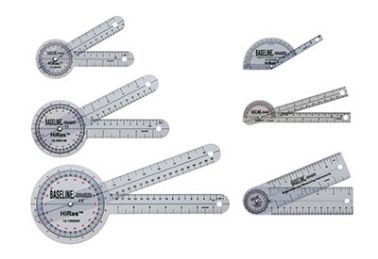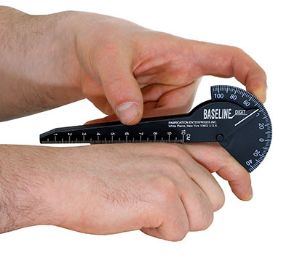










~2.jpg&newheight=260&quality=80)




What are Goniometer Range of Motion Instruments?
Range of motion, also referred to as ROM, refers to the range of motion of a joint from full extension to full flexion, or bending, measured in degrees, just like with a circle. A therapist typically measures a joint’s ROM by utilizing functional or active measurements along with passive measurements. When a patient moves the body and joint without help, this is functional or active measurement. When the medical professional moves the joint without the assistance of the patient, this is passive measurement. The patient’s pain levels and amounts of movement are monitored and recorded through this assessment process.
ROM measurements are often taken after an injury or accident to a specific body part. This helps to provide a baseline from which physicians can set a treatment protocol and monitor improvement. While physical therapists and other medical professionals may use other tools of the trade in determining a patient’s health and wellness capabilities, they most often use goniometry and an inclinometer to find out a patient’s specific range of motion abilities.
Range of motion testing involves taking measurements not just of the injured joint, but of healthy joints as well. This comparison further helps the physician to narrow down limitations, severity and the degree of the injury incurred.
Goniometers specifically test the angle of joints, providing measurements from 0 degrees to 180 or 360 degrees. Available in varying styles, designs and configurations, goniometers are sometimes made for specific body areas such as individual fingers, while others are more universal in design, able to measure all areas of the body. Extendable goniometers offer versatility for measuring both large and small joints.
Goniometers are used to measure the joint’s angle, with two movable arms connected like a protractor. For example, if a goniometer is used to measure elbow flexion, the fulcrum/center of this instrument is placed at the elbow. As the elbow is bent inward, the movable arms of the goniometer align to the arm on either side to determine the angled degree of movement the patient is able to make. How far the elbow bends is referred to as the patient’s functional range of motion for elbow flexion.
Because decreased motion in a joint translates to decreased ability for the patient to use that joint fully, the only ways to determine if the functional ROM in a joint is limited is to measure the joint at the end of the motion and again at rest. Goniometers are often used for this purpose.
An inclinometer measures a patient’s body positioning and stability in various areas, recording the slope and tilt of the joints. This small device is typically placed on the body close to the joint, with the dial set to zero. The therapist will take the patient through several ROM movements, with readings displayed on the dial of the inclinometer. Therapists will sometimes use two interconnected inclinometer devices to more accurately measure ROM for the spine along with stability angles. A dual inclinometer is often employed while testing the upper and lower spine at the same time, with one placed on the cervical or upper thoracic areas, and the other device placed on the lumbar area.
Hulet Smith, OT
Rehabmart Co-Founder & CEO
ck